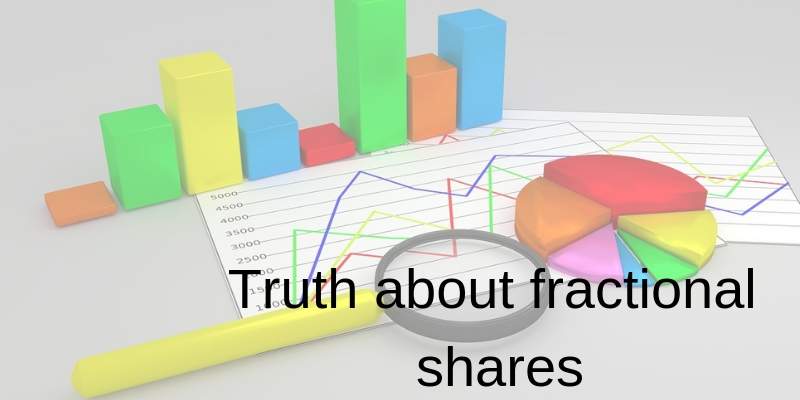
Most people, especially the millennials of our time, may not know about Fractional Shares or what they are. And that can be a grave mistake, especially when looking to invest. Everyone who aims to be anyone in the investment industry needs to know all there is to know about Fractional Shares and be smart in their dealings with them as well. Mark you, there are also technical terms involved that surround this very topic that you must be knowledgeable about to even understand what Fractional Shares are. And that’s exactly what we aim to share with you in this article.
What is a Fractional Share?
This is a share of equity that is usually less than the full share. Thus, the name fractional share. In most instances, Fractional Shares result from stock splits or dividend reinvestment plans or other similar corporate actions. But then, it is also key to note that you cannot acquire Fractional Shares from the market. Pus, in as much as they always hold some value to the investors that have them, they can be quite difficult to sell. But not impossible.
Breaking down Fractional Shares
If, for example, an investor holding Fractional Shares aim to sell them, then it must be through a major brokerage firm. These firms can then pair these shares with their other partial shares to make them one whole share which can then be sold. However, supposing the selling stock doesn’t have enough high demand at the time of the selling in the market place, then selling Fractional Shares can be a lot harder. Not to mention, also take a lot longer than the investors expect.
Shares that result from a stock split
As mentioned earlier, Fractional Shares can also result from stock splits. By this, we mean that situations where a company has, for example, a 3-for-2 stock split. Where, in this instance, you have three shares of a certain, X corporation. And the corporation has a 3-for-2 stock split. When this happens, it lies upon you, the investor to look for the extra 1½ shares to make it 4½ shares in total. Plus, by now you should already know that you cannot sell a half share in the stock market. But then, if you are able to obtain a fractional share, then you can make the sale as with any other whole share.
But then, you find that most companies usually round up the split stocks into the nearest whole number whenever fractional shares do occur. Therefore, as with X corporation, they may choose to round off their Fractional ½ share to leave it at 5 shares. And this helps to make the investors’ work a lot easier as well when trying to sell their shares.
Fractional Shares that result from an acquisition or merger
You can also acquire fractional shares through an acquisition or merger of two companies. In such a scenario, the companies that combine to form one company usually calculate the new common stock shares using a predetermined ratio. During this time, some investors and shareholders in both the companies may end up with Fractional Shares of the new common stock. These companies may then choose to round up these fractional shares to form the nearest round number for each fraction share or not. If they don’t, it lies upon the investors and shareholders to look for major brokerage firms to help merge their Fractional Shares into one whole share for sale. And with today’s business industry where companies buy and sell to one another or merge, you shouldn’t be surprised if you end up with a Fractional Share is the company you invested in merges with another.
Mutual funds Fractional Shares
You find that most mutual fund investors reinvest both their dividends and capital gains distributions in most occasions. And usually, this always leaves the investors with some fractional mutual fund shares to deal with. And, unlike stocks that usually trade instantaneously when there is an exchange, the mutual fund fractional shares are always a lot easier to sell. Thanks to the fact that mutual funds are not always that difficult to reinvest and sell even at the end of market days, brokerage firms find it a lot easier to compile these fractional shares.
Partial or odd-lot bonds
It’s usually not that common to find investors with odd numbers of bonds. Being that individual bonds are often sold in increments like in 10s, 20s, 50s, and 100s. Therefore, finding an investor who is looking to sell, say 11 bonds on the market place often end up leaving the seller with an order not fulfilled. If not, then the chances of there being inaccurate pricing in the sale are usually high. But then again, you also find that it is always a lot more difficult to purchase bonds that are not being sold in increments. But that doesn’t mean that it doesn’t occur sometimes. Say, for example, you inherit bonds. That you were to inherit half of 25 bonds. This would leave you with an odd of 12½ bonds.
And so, if the investor who inherits the bonds wants to sell them, then these bonds will have to be packaged in lots of 10. And the remaining 2½ bonds will then need to be packaged with other fractional bonds to make them reach 10 for them to be sold. If you look at it from this perspective, you can say that it’s all just simple mathematics. However, the practical process isn’t as easy nor is it swift. It can take a while before you find other partial bonds to add up to reach a lot of 10.
Final thoughts
Fractional Shares can occur and do occur. However, it is essential to note that when you find yourself with fractional shares as a result of a stock split, dividend reinvestment plan, or even a merger or acquisition of your invested company, you can still make a sale. Only that, it will be more of a process then than when selling full shares.





